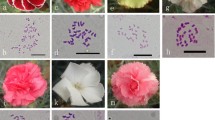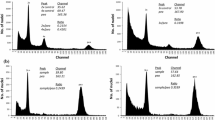Summary
-
1.
From 4 n×2 n and reciprocal crosses within Dactylis glomerata subsp. lusitanica and D.g. subsp. smithii and between these two subspecies, two triploids, two polyhaploids and a 3n+1 plant were obtained. The two subspecies differ considerably as regards the extent of crossability with respect to intrasubspecific 2n×4n and recriprocal crosses.
-
2.
The cytology of the triploid Dg(1 x sm) 933-III-6 and the 3n+1 plant Dgl 936-I-6 was studied. Chiasma frequency and multivalent frequency per chromosome for these two plants was compared. The frequency distribution for trivalents in the Dg (1 x sm) 933-III-6 plant was compared with the expected binomial distribution. There was a good fit. Data show no evidence for structural differentiation between the two subspecies.
-
3.
In the triploid plant, at anaphase I the distribution of chromosomes did not deviate significantly from a binomial distribution.
-
4.
The triploid and 3n+1 plant had nearly 28% pollen fertility. The 3n+1 plant had significantly higher variance for pollen grain size than the diploid lusitanica plant.
-
5.
From crosses of an asynaptic plant with a normal diploid a primary trisomic plant was obtained. Cytology of the trisomic was studied. In nearly half of the PMCs a trivalent was formed.
Similar content being viewed by others
References
Chase, S. S.: Monoploid frequencies in a commercial double cross hybrid maize and its component single cross hybrids and inbred lines. Genetics 34, 328–332 (1949).
Darlington, C. D., and K. Mather: The origin and behaviour of chiasmata, III. Triploid Tulipa. Cytologia (Tokyo) 4, 1–15 (1933).
Einset, J.: Chromosome length in relation to transmission frequency of maize trisomes. Genetics 28, 349–364 (1943).
McClintock, B.: A cytological and genetical study of triploid maize. Genetics 14, 180–222 (1929).
McCollum, G. D.: Comparative studies of chromosome pairing in natural and induced tetraploid Dactylis. Chromosoma (Berl.) 9, 571–605 (1958).
Müntzing, A.: Studies on meiosis in diploid and triploid Solanum tuberosum L. Hereditas (Lund) 17, 223–245 (1933); - The effects of chromosomal variation in Dactylis. Hereditas (Lund) 23, 113–235 (1937); - Characteristics of two haploid twins in Dactylis glomerata. Hereditas (Lund) 29, 134–140 (1943).
Povilaitis, B., and J. B. Boyes: A cytological study of autotetraploid red clover. Amer. J. Bot. 43, 169–174 (1956).
Rick, C. M., and D. W. Barton: Cytological and genetical identification of the primary trisomics of the tomato. Genetics 39, 640–666 (1954).
Satina, S., and A. F. Blakeslee: Chromosome behavior in triploids of Datura stramonium. I. The male gametophyte. Amer. J. Bot. 24, 518–527 (1937a); - Chromosome behavior in triploid Datura II. The female gametophyte. Amer. J. Bot. 24, 621–627 (1937b).
Shah, S. S.: Studies on supernumerary chromosomes in the genus Dactylis. Chromosoma (Berl.) 14, 162–185 (1963).
Snedecor, G. W.: Statistical methods applied to experiments in agriculture and biology. Bombay: Allied Pacific Private Ltd. Indian Edit. 1961.
Stone, L. H. A., and K. Mather: The origin and behaviour of chiasmata, IV Diploid and triploid Hyacinthus. Cytologia (Tokyo) 4, 16–25 (1933).
Sturtevant, A. H.: Preferential segregation in triplo-IV females of Drosophila melanogaster. Genetics 21, 444–466 (1936).
Wilson, J. Y.: Cytogenetics of triploid bluebells, Endymion nonscriptus (L.) Garcke and E. hispanicus (Mill.) Chouard. Cytologia (Tokyo) 23 (4), 435–446 (1958).
Zohary, D., and U. Nur: Natural triploids in the orchard grass Dactylis glomerata L. Polyploid complex and their significance for gene flow from diploid to tetraploid levels. Evolution (Lancaster, Pa.) 13, 311–317 (1959).
Author information
Authors and Affiliations
Rights and permissions
About this article
Cite this article
Shah, S.S. Studies on a triploid, a tetrasomic triploid and a trisomic plant of Dactylis glomerata. Chromosoma 15, 469–477 (1964). https://doi.org/10.1007/BF00368142
Received:
Issue Date:
DOI: https://doi.org/10.1007/BF00368142




